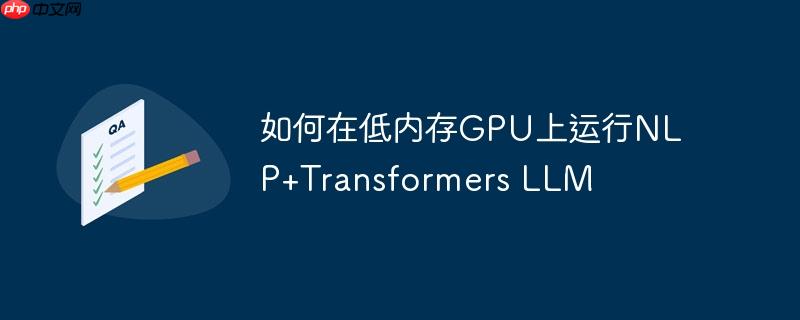
本文旨在解决在低内存GPU上运行大型语言模型(LLM)时遇到的内存不足问题。通过模型量化和使用AutoAWQ工具,结合针对特定CUDA版本的兼容性调整,提供了一种可行的解决方案,并详细展示了如何在代码中应用这些优化策略,确保模型能够成功加载并运行在资源受限的环境中.
在尝试运行大型语言模型(LLM)时,尤其是在资源有限的GPU上,经常会遇到内存不足的问题。这通常是因为模型参数量巨大,超出GPU的承载能力。本文将介绍一种有效的解决方案:模型量化,以及如何使用 AutoAWQ 工具来加载和运行量化后的模型。
模型量化是一种通过降低模型参数的精度来减少模型大小的技术。例如,将原本使用32位浮点数(float32)存储的参数转换为8位整数(int8),从而显著减少模型的内存占用。量化后的模型不仅体积更小,还能提高推理速度,使其更适合在资源受限的设备上运行。
AutoAWQ 是一个专门用于量化和加载模型的库,它能够方便地将大型模型转换为量化版本,并在支持的硬件上高效运行。
1. 安装必要的库
首先,需要安装 transformers 和 accelerate 库,以及特定版本的 AutoAWQ。由于不同环境的CUDA版本可能不同,需要选择与你的CUDA版本兼容的 AutoAWQ 版本。
!pip install -q transformers accelerate !pip install -q -U https://www.php.cn/link/9b67ff5862eb652ed35b0554cb7f62f2/download/v0.1.6/autoawq-0.1.6+cu118-cp310-cp310-linux_x86_64.whl
注意: 上面的命令安装的是针对CUDA 11.8的版本。你需要根据你的CUDA版本选择合适的AutoAWQ whl文件。你可以在AutoAWQ的GitHub Releases页面找到其他CUDA版本的whl文件。
2. 加载量化模型和tokenizer
接下来,使用 AutoAWQForCausalLM 的 from_quantized 方法加载量化后的模型。同时,加载对应的tokenizer。
import torch from awq import AutoAWQForCausalLM from transformers import AutoTokenizer model_name = 'TheBloke/neural-chat-7B-v3-1-AWQ' # 选择量化后的模型 model = AutoAWQForCausalLM.from_quantized(model_name) tokenizer = AutoTokenizer.from_pretrained(model_name)
注意: TheBloke 在 Hugging Face 上提供了许多量化后的模型,你可以根据你的需求选择合适的模型。
3. 修改推理代码
在推理代码中,需要将输入张量移动到GPU上。这可以通过 .cuda() 方法实现。
def generate_response(system_input, user_input):
# Format the input using the provided template
prompt = f"### System:\n{system_input}\n### User:\n{user_input}\n### Assistant:\n"
# Tokenize and encode the prompt
inputs = tokenizer.encode(prompt, return_tensors="pt", add_special_tokens=False).cuda()
# Generate a response
outputs = model.generate(inputs, max_length=1000, num_return_sequences=1)
response = tokenizer.decode(outputs[0], skip_special_tokens=True)
# Extract only the assistant's response
return response.split("### Assistant:\n")[-1]4. 示例运行
# Example usage system_input = "You are a math expert assistant. Your mission is to help users understand and solve various math problems. You should provide step-by-step solutions, explain reasonings and give the correct answer." user_input = "calculate 100 + 520 + 60" response = generate_response(system_input, user_input) print(response)
通过模型量化和使用 AutoAWQ 工具,可以在低内存GPU上成功运行大型语言模型,为资源受限的环境提供强大的NLP能力。
以上就是如何在低内存GPU上运行NLP+Transformers LLM的详细内容,更多请关注php中文网其它相关文章!

每个人都需要一台速度更快、更稳定的 PC。随着时间的推移,垃圾文件、旧注册表数据和不必要的后台进程会占用资源并降低性能。幸运的是,许多工具可以让 Windows 保持平稳运行。

Copyright 2014-2025 https://www.php.cn/ All Rights Reserved | php.cn | 湘ICP备2023035733号